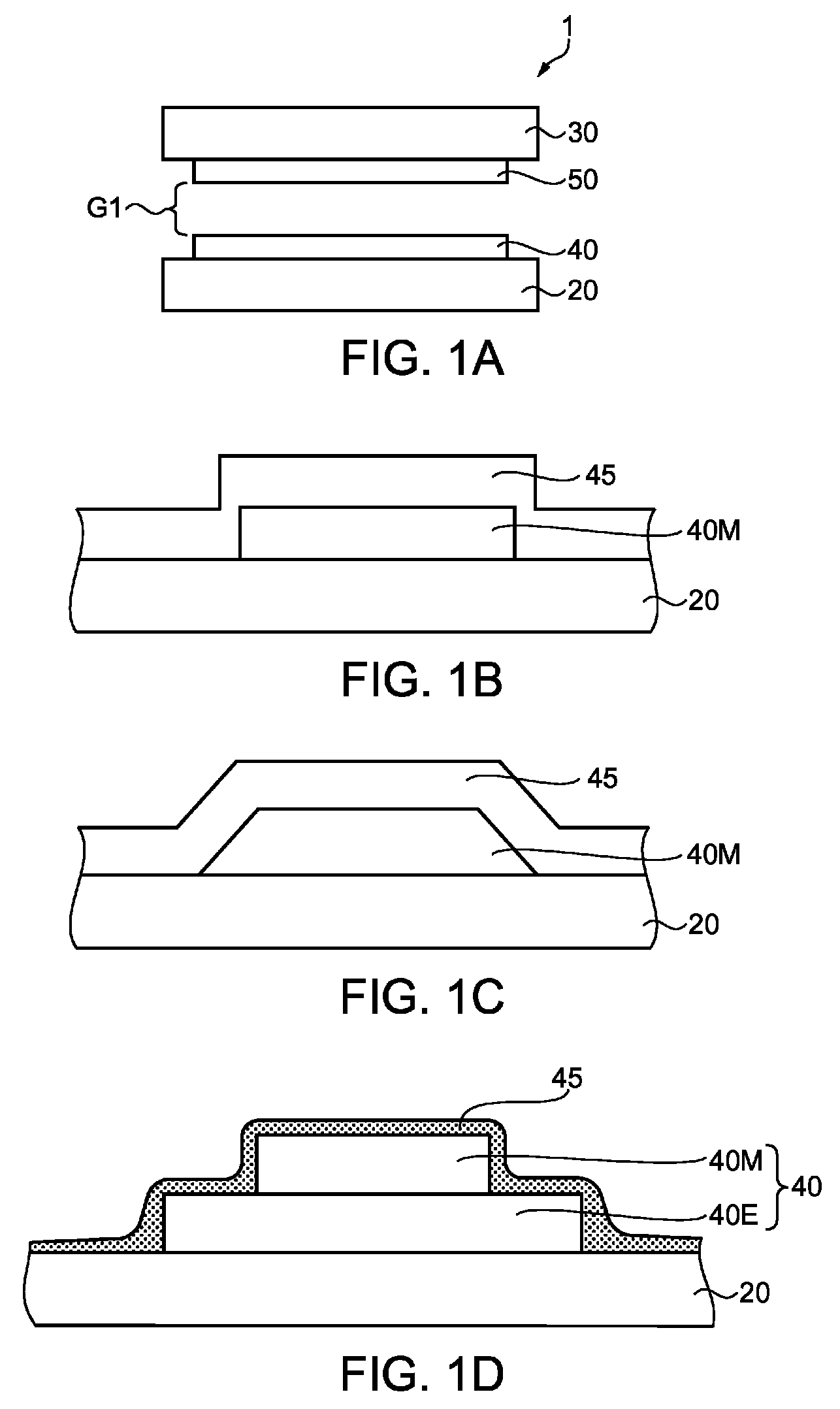Interference filter, optical module, and electronic apparatus
a technology of optical modules and filters, applied in the direction of optical radiation measurement, instruments, spectrometry/spectrophotometry/monochromators, etc., can solve the problems of low long-term reliability of silver, easy sulfurization, low heat resistance of silver, etc., and achieve high reliability
- Summary
- Abstract
- Description
- Claims
- Application Information
AI Technical Summary
Benefits of technology
Problems solved by technology
Method used
Image
Examples
first embodiment
[0048]FIGS. 1A through 1D are diagrams showing an example of the structure of an optical film in an interference filter. As shown in FIG. 1A, an interference filter 1 has a first substrate 20 and a second substrate 30 held in parallel to each other, a first optical film 40 disposed on the first substrate 20, and a second optical film 50 disposed on the second substrate 30. The first substrate 20 or the second substrate 30 is, for example, a glass substrate having transmissivity with respect to the light in a desired wavelength band.
[0049]Further, the first optical film 40 and the second optical film 50 are formed so as to be opposed to each other and have a predetermined gap G1 therebetween. It should be noted that it is possible to make the gap G1 variable, and such a variable wavelength interference filter (hereinafter also referred to as an etalon) will be described later. The first optical film 40 and the second optical film 50 are provided with both of a reflecting property and...
second embodiment
[0084]Then, an optical module and an electronic apparatus using the etalon explained in the first embodiment described above will be explained. In the second embodiment, a colorimetric device for measuring the chromaticity of a measurement object will be explained as an example.
[0085]FIG. 3 is a block diagram showing a configuration of the colorimetric device.
[0086]A colorimetric device 80 is provided with a light source device 82 for irradiating a test object A with the light, a colorimetric sensor 84 (an optical module), and a control device 86 for controlling an overall function of the colorimetric device 80.
[0087]The colorimetric device 80 is a device for irradiating the test object A with the light from the light source device 82, receiving the test target light reflected by the test object A using the colorimetric sensor 84, and analyzing and then measuring the chromaticity of the test target light based on a detection signal output from the colorimetric sensor 84.
[0088]The li...
third embodiment
[0102]An example of the gas detection device will hereinafter be explained with reference to the accompanying drawings.
[0103]FIG. 4 is a cross-sectional view showing an example of the gas detection device provided with the etalon.
[0104]FIG. 5 is a block diagram showing a configuration of a control system of the gas detection device.
[0105]As shown in FIG. 4, a gas detection device 100 is configured including a sensor chip 110, a channel 120 provided with a suction port 120A, a suction channel 120B, an exhaust channel 120C, and an exhaust port 120D, and a main body section 130.
[0106]The main body section 130 is composed of a detection section (an optical module) including a sensor section cover 131 having an opening to which the channel 120 is detachably attached, an exhaust section 133, a housing 134, an optical section 135, a filter 136, the etalon (the variable wavelength interference filter) 5, alight receiving element 137 (a light receiving section), and so on, a control section ...
PUM
 Login to View More
Login to View More Abstract
Description
Claims
Application Information
 Login to View More
Login to View More - R&D
- Intellectual Property
- Life Sciences
- Materials
- Tech Scout
- Unparalleled Data Quality
- Higher Quality Content
- 60% Fewer Hallucinations
Browse by: Latest US Patents, China's latest patents, Technical Efficacy Thesaurus, Application Domain, Technology Topic, Popular Technical Reports.
© 2025 PatSnap. All rights reserved.Legal|Privacy policy|Modern Slavery Act Transparency Statement|Sitemap|About US| Contact US: help@patsnap.com



